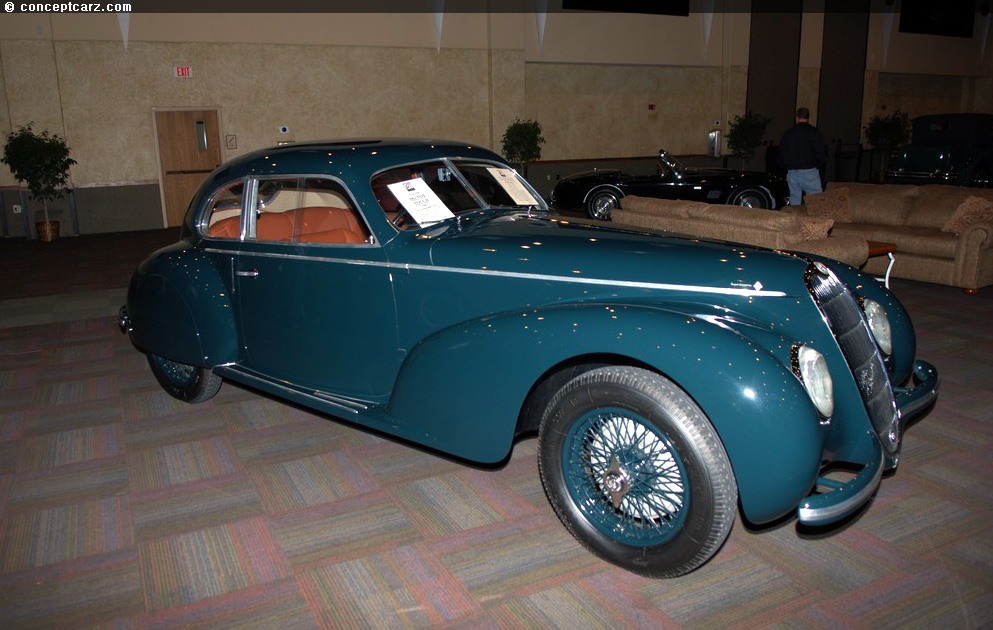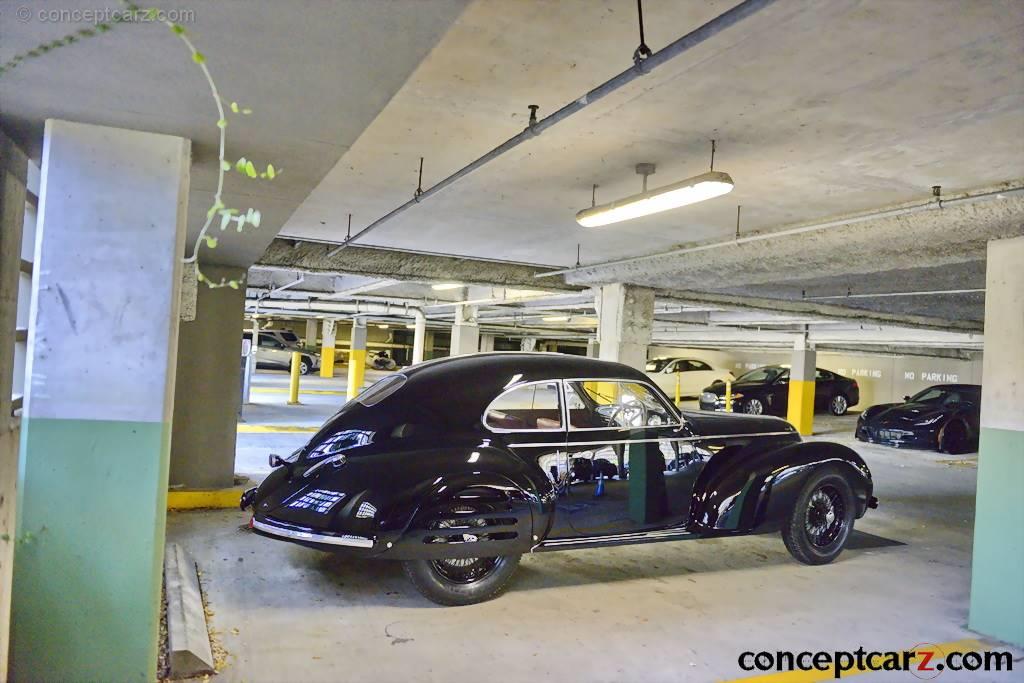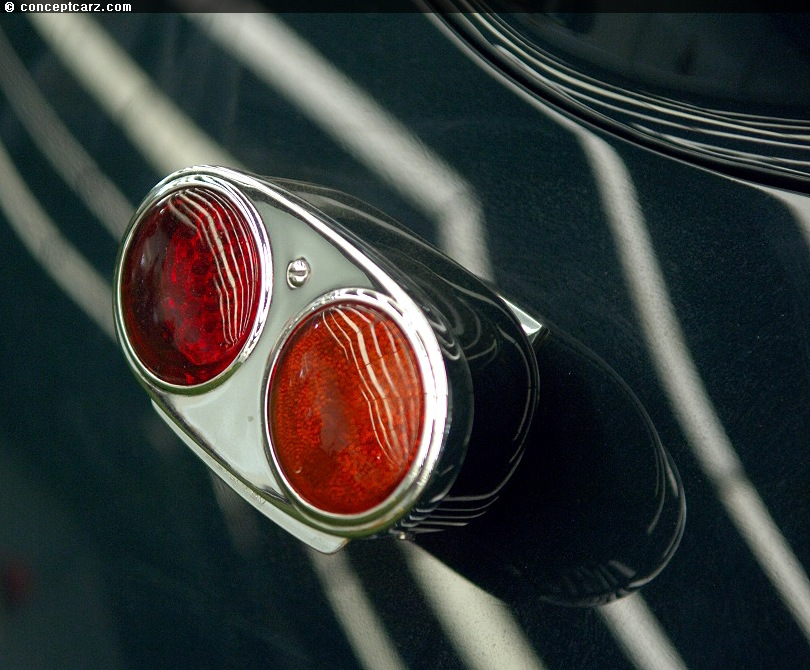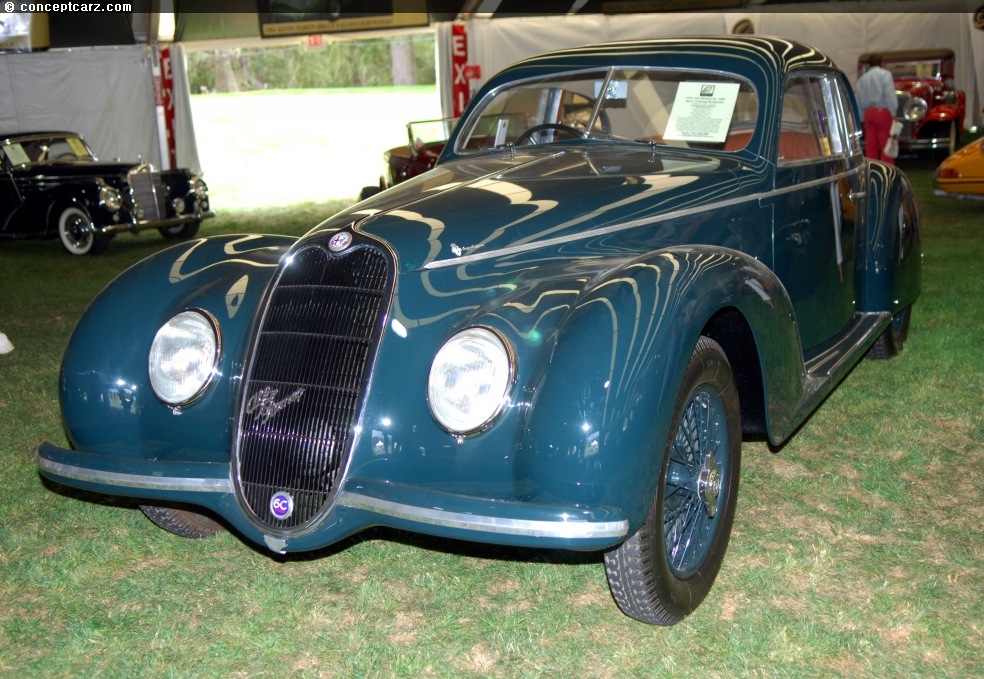The Vittorio Jano-designed six-cylinder Alfa Romeo '6C' model was produced between 1927 and 1954, with displacements doubling during that time, from 1.5-liters in the 6C 1500 (of 1927 through 1929) to 3-liters in the 6C 3000 (of 1948 through 1954). The basic design of the 6C 1500 would ultimately lead the company to the top of the Grand Prix competition with the P2 and P3 Tipo B Monoposto.
Sport Touring Berlinetta by Touring
Chassis #: 915030
Engine #: 823113
View info and history
Auction entries : 2Vittorio Jano succeeded Giuseppe Merosi as Alfa's head of design in 1926, creating a new overhead-cam, 1.5-liter, inline six-cylinder engine which officially entered production in 1927 as the 6C 1500. The Sport version, which arrived a year later, had twin overhead camshafts and a boost in power by 10 to 54 horsepower. The 6C 1500 Super Sport arrived in 1929, and with the optional Roots supercharger, the output was rated at 76 horsepower. Displacement grew to 1,752 cubic centimeters resulting in the 6C 1750 of 1929. The base version had single overhead camshafts, while the Super Sport and Gran Sport had a double overhead camshaft design. Over the six years of 6C 1750 production, the model was developed through four series of gradual improvements, with nearly 2,600 examples built in total. The 6C 1750 enjoyed both sales and competition success and in factory competition form, was arguably the most successful Alfa Romeo model to date, with five major victories in 1929 alone. Giuseppe Campari won the Mille Miglia, and the 6C 1750 took the top three places at the 1930 Tourist Trophy and the 1930 Mille Miglia.
Sport Touring Berlinetta by Touring
Chassis #: 915030
Engine #: 823113
View info and history
Auction entries : 2The final derivative of the original 6C 1600 was the 6C 1900 of 1933, of which just 197 examples were built. The double overhead camshaft, naturally aspirated engine of the 6C 1900 displaced 1,917cc and offered 68 horsepower at 4,500 RPM. This was the first time that the cylinder head of the 6C was constructed from aluminum. Previously, some engines had been built with an aluminum block; most were built from cast iron. 1933 was the same year that Alfa Romeo was taken over by the Italian government, and during the immediate years that followed, the company concentrated on manufacturing aircraft engines and military supplies for the war in Africa. Due to the hardships of the Great Depression, Alfa Romeo faced financial difficulties so severe that it was bailed out by the State. Surprisingly, instead of downsizing and switching to utilitarian, saleable automobiles to generate cash flow, Italy directed Alfa to construct racing machines that could dominate the racing circuits throughout Europe, demonstrating Italy's technology, resolve, and competitiveness. The 6C 2300
Constant development brought about the development of a new six-cylinder 2,309cc engine with an integrally cast crankcase, seven main bearing crankshaft, and cylinder block capped by an aluminum-alloy cylinder head. The cams were chain-driven to the sprocket, then via spur gears. Designed for performance without the expense or complication of a supercharger, the 6C 2300 offered 68 horsepower at 4,400 RPM in standard guise.
Sport Touring Berlinetta by Touring
Chassis #: 915.005
Engine #: 923.880
View info and history
Auction entries : 1The Gran Turismo used a short-wheelbase platform, while the longer-wheelbase version was known as the Turismo. The Turismo received a single downdraft Solex carburetor, while the Sport and Super Sport versions were equipped with three side-draft Weber carburetors. The front suspension was comprised of trailing arms and coil springs, while the rear employed swing axles and longitudinal torsion bars, along with tube shocks all round. The 6C 2300 made its competition debut at the inaugural 'Giro d'Italia - Coppa d'Oro del Littorio' - a 5,687-kilometer race held in three stages. Alfa Romeo's racing department, Scuderia Ferrari, fielded four cars with open coachwork by Brianza. Three of the Alfa Romeos finished the race, placing 2nd, 4th, and 5th. A short time later, in August of 1934, at the 'Targa Abruzzo - 24 Ore di Pescara', three Touring-bodied coupes placed 1st, 2nd, and 3rd. Production of the 6C 2300 lasted through 1938, with 760 examples of the rigid-axle version and 870 of the independently sprung 6C 2300B version. The 6C 2500
A descendent of the prewar Jano-designed racing machines, introduced just before the onset of hostilities in Europe, and returning to production in the post-War era, the 6C 2500 was the ultimate iteration of Jano's '6C' six-cylinder engine. Introduced in 1938 and produced through 1952, it was the last Alfa model hand-built on a separate chassis, and one of the most expensive and sophisticated cars of its era.
Sport Touring Berlinetta by Touring
Chassis #: 915030
Engine #: 823113
View info and history
Auction entries : 2The cylinder bore of the 6C 2300 was increased by two millimeters, and an improved cylinder head was added for better aspiration and increased compression from 6.5:1 to 7.1:1. The result was a 2,443cc displacement and the birth of the 6C 2500. It produced 95 horsepower and was complimented by lightweight aluminum coachwork installed in a nimble steel ladder frame chassis and offered with three wheelbases. The Turismo used the 128-inch platform, the Sport on the 118.1-inch, and the Super Sport on the 106.3-inch version. Most received Superleggera coachwork by Touring of Milan. All 6C 2500 models were built in right-hand drive configuration with four-speed transmissions, with synchromesh on the top two gears, except for the Super Sport and Competizione, which were fully synchromesh. The competition variant of its 6C 2500 was called the Super Sport, or Tipo 256, which referenced the 2.5-liter, six-cylinder engine. Development of this special model was overseen by the company's works racing teams - Alfa Corse in Milan and Scuderia Ferrari in Modena. The Tipo 256 was unveiled in 1939 at the Berlin Motor Show.The Tipo 256 rested on a shortened frame and although specifications varied, most received competition features such as a larger-capacity aluminum fuel tank, aluminum-rim Borrani wire wheels, a lowered radiator, and stiffer suspension springs. The highly tuned engines had increased compression, a special ignition, a tubular exhaust manifold, triple Weber carburetors with ram air horns, and developed 125 horsepower. The Tipo 256 represents the final collaboration between Alfa Romeo and Scuderia Ferrari.
Sport Touring Berlinetta by Touring
Chassis #: 915030
Engine #: 823113
View info and history
Auction entries : 2After the war, Alfa Romeo built three prototypes of the 6C 3000 with a three-liter engine that had two valves per cylinder, chain-driven dual overhead camshafts, an aluminum head with hemispherical combustion chambers, and a cast-iron block. It used unit-body construction with a wheelbase measurement of 120 inches. The suspension was independent with double wishbones and coil springs at the front and trailing arms and transverse torsion bars at the rear. The project was later abandoned as the company focused on building a smaller four-cylinder model called the Alfa Romeo 1900, which would enter production in 1950 and remain through 1959.
by Daniel Vaughan | Mar 2022

Sport Touring Berlinetta by Touring
Chassis #: 915030
Engine #: 823113
View info and history
Auction entries : 2

Sport Touring Berlinetta by Touring
Chassis #: 915030
Engine #: 823113
View info and history
Auction entries : 2
Constant development brought about the development of a new six-cylinder 2,309cc engine with an integrally cast crankcase, seven main bearing crankshaft, and cylinder block capped by an aluminum-alloy cylinder head. The cams were chain-driven to the sprocket, then via spur gears. Designed for performance without the expense or complication of a supercharger, the 6C 2300 offered 68 horsepower at 4,400 RPM in standard guise.

Sport Touring Berlinetta by Touring
Chassis #: 915.005
Engine #: 923.880
View info and history
Auction entries : 1
A descendent of the prewar Jano-designed racing machines, introduced just before the onset of hostilities in Europe, and returning to production in the post-War era, the 6C 2500 was the ultimate iteration of Jano's '6C' six-cylinder engine. Introduced in 1938 and produced through 1952, it was the last Alfa model hand-built on a separate chassis, and one of the most expensive and sophisticated cars of its era.

Sport Touring Berlinetta by Touring
Chassis #: 915030
Engine #: 823113
View info and history
Auction entries : 2

Sport Touring Berlinetta by Touring
Chassis #: 915030
Engine #: 823113
View info and history
Auction entries : 2
by Daniel Vaughan | Mar 2022
Related Reading : Alfa Romeo 6C History
The Alfa Romeo 6C 2500 was introduced near the end of the 1930s. The 6C name was derived from the engine size, an inline-six while the 2500 represented the engines cubic-centimeter displacement size. The engine was a version of Vittorio Jano designed a six-cylinder engine. The 6C was available in a plethora of body styles and wheelbases and was produced during two different times in history.....
Continue Reading >>
Continue Reading >>
Related Reading : Alfa Romeo 6C 2500 History
The engine in the 1927 Alfa Romeo 6C 1500 was the basis for a series of engines that would eventually define the marque as one of the great manufacturers of the pre-war era. The Vittorio Jano-designed engine was expanded to 1752cc and became the 6C 1750, which, in various body styles and tunes, would become the backbone of Alfa Romeo production from 1929 to 1933. Two additional cylinders were later....
Continue Reading >>
Continue Reading >>
Similarly Sized Vehicles
from 1939
Alfa Romeo Monthly Sales Volume
March 2023
2,390
1939 Alfa Romeo 6C 2500 Vehicle Profiles
Recent Vehicle Additions
Performance and Specification Comparison
6C 2500 Specification Comparison by Year
Year
Production
Wheelbase
Engine
Prices
Related Automotive News

1939 Alfa Romeo 6C 2500 S by Corrado Lopresto awarded Best of Show at inaugural Concorso d'Eleganza Varignana 1705
A 1939 Alfa Romeo 6C 2500 S Berlinetta Touring triumphed with Best of Show at the first-ever Concorso dEleganza Varignana 1705
Other winners from across the other five competition classes were Alfa Romeo 6C 1750 SS from 1929 FIAT 1100 E Vistot...

Phenomenal Ferraris and Italian Thoroughbreds Offered at Gooding & Company's Pebble Beach Auctions
The auction house announced a stable of Italian star cars, including a 1950 Ferrari 166 MM Berlinetta Le Mans, a 1961 Ferrari 400 Superamerica Series I Coupe Aerodinamico, and a 1954 Ferrari 500 Mondial Series I Spider.
A stunning group of star...

Curtain Falls On Record-Breaking Salon Privé Week
Top marques unveil exciting new models at Blenheim Palace
Ex-Nuvolari Alfa Romeo 8C 2300 crowned Best of Show in Concours dElégance presented by AXA
Evolution of the Supercar celebrated in Salon Privé Masters by Pirelli and Lockton
Classic %26 Su...

Ex-Scuderia Ferrari Alfa Romeo 8C 2300 Monza Spider By Zagato Scoops Best Of Show At Salon Privé
Alfa Romeo 8C 2300 Monza Spider by Zagato raced by Tazio Nuvolari wins top award
Leading designers present inaugural Churchill Cup to rare Lancia Astura
Duke of Marlborough selects his favourites on two wheels and four
Record entry for the UKs...

'Picture Perfect' Legendary Alfa Romeo Leads Bonhams Quail Motorcar Auction
A picture perfect, rare and highly original example of the legendary pre-war Alfa Romeo 8C 2300 will be the top lot offered in the Bonhams Quail Motorcar Auction on 14 August, with an estimate of US%246,500,000 - 7,500,000 (£4,900,000 - 5,700,000).
With...

2015 Pebble Beach Concours d'Elegance Best of Show
PEBBLE BEACH, Calif. (August 17, 2015) -- An Italian Isotta Fraschini Tipo 8A Cabriolet that once turned heads and garnered top prizes in the classic era glided to victory at the 65th Pebble Beach Concours dElegance on Sunday.
The competition...
























